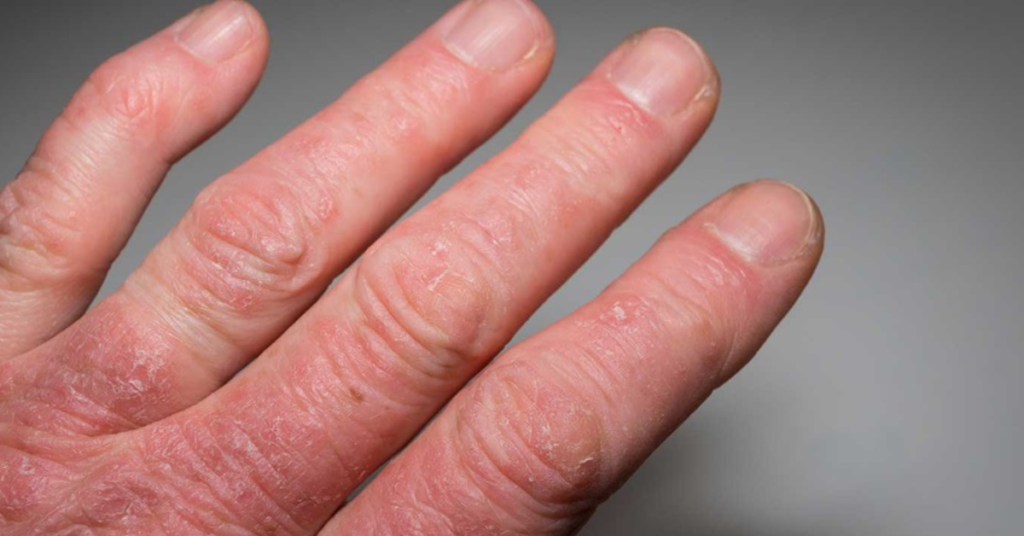Psoriatic arthritis (PsA) is a chronic autoimmune disease that affects both the skin and joints. It is a form of inflammatory arthritis that develops in some people with psoriasis, a skin condition characterized by red, scaly patches. This complex interplay between skin and joints makes Psoriatic Arthritis a unique and challenging condition to manage. In this article we will delve into the key aspects of Psoriatic Arthritis, including its symptoms, causes, diagnosis and available treatments.
The Link between Psoriasis and Psoriatic Arthritis
Psoriasis is a chronic skin condition that results from an overactive immune system, causing rapid skin cell turnover. In individuals with Psoriatic Arthritis, the immune system not only attacks the skin cells but also targets the joints, leading to inflammation. It’s crucial to understand that not everyone with psoriasis will develop Psoriatic Arthritis, and the severity of skin symptoms doesn’t necessarily correlate with joint involvement.
Symptoms of Psoriatic Arthritis
Psoriatic Arthritis can manifest in various ways, and the symptoms can range from mild to severe. The most common symptoms include joint pain, swelling, and stiffness, which often mimic other forms of arthritis. Additionally, individuals with Psoriatic Arthritis may experience skin issues such as red, scaly patches typical of psoriasis. Other symptoms may include fatigue, nail changes, and even eye inflammation. Recognizing these symptoms early is crucial for a prompt diagnosis and effective management.
Diagnosis and Differential Diagnosis
Diagnosing Psoriatic Arthritis can be challenging, as its symptoms can resemble other forms of arthritis, such as rheumatoid arthritis or osteoarthritis. A comprehensive evaluation by a rheumatologist is essential for an accurate diagnosis. Medical history, physical examinations, imaging studies, and blood tests are often part of the diagnostic process. The presence of psoriasis, nail changes, and family history can be significant indicators. It is important to distinguish Psoriatic Arthriti’s from other conditions to tailor the treatment plan accordingly.
Causes and Risk Factors
The exact cause of Psoriatic Arthriti’s is not fully understood, but a combination of genetic and environmental factors is believed to contribute to its development. Having a family history of psoriasis or Psoriatic Arthriti’s increases the risk. Additionally, certain triggers such as infections or injuries can exacerbate the condition. Research is ongoing to unravel the specific factors that lead to the onset of Psoriatic Arthritis, providing valuable insights into potential preventive measures.
Types of Psoriatic Arthritis
Psoriatic Arthriti’s is not a one-size-fits-all condition; it comes in different forms. These include symmetric arthritis, asymmetric arthritis, spondylitis, and arthritis mutilans. Symmetric arthritis affects joints on both sides of the body, similar to rheumatoid arthritis. Asymmetric arthritis involves inflammation in different joints on each side. Spondylitis primarily affects the spine, leading to stiffness and pain. Arthritis mutilans is a severe, but less common, form that can cause joint deformities.
Treatment Options
Managing Psoriatic Arthriti’s requires a comprehensive approach, often involving a combination of medications, lifestyle modifications, and sometimes surgical interventions. Nonsteroidal anti-inflammatory drugs (NSAIDs), disease-modifying antirheumatic drugs (DMARDs), and biologics are commonly prescribed to reduce inflammation and slow disease progression. Physical therapy and regular exercise can help maintain joint function and reduce stiffness. In some cases, surgery may be recommended to repair or replace damaged joints.
Living with Psoriatic Arthritis
Living with Psoriatic Arthriti’s can be challenging, but with proper management, individuals can lead fulfilling lives. It’s crucial to work closely with a healthcare team, including rheumatologists, dermatologists, and physical therapists, to tailor a treatment plan that addresses both skin and joint symptoms. Support groups and patient advocacy organizations can also provide valuable resources and a sense of community for individuals navigating the complexities of Psoriatic Arthritis.
Research and Future Directions
Ongoing research is essential to deepen our understanding of Psoriatic Arthriti’s and develop more targeted and effective treatments. Advances in genetics, immunology, and pharmacology continue to pave the way for innovative therapies. Investigating the link between the skin and joint inflammation in Psoriatic Arthriti’s may uncover new insights into autoimmune diseases, potentially leading to breakthroughs in treatment and prevention.
Conclusion
Psoriatic Arthriti’s is a multifaceted condition that requires a holistic approach to management. By understanding the connection between skin and joints, healthcare professionals can tailor treatment plans to address the unique challenges posed by Psoriatic Arthritis. With ongoing research and advancements in medical science, there is hope for improved outcomes and a better quality of life for individuals living with this complex autoimmune disease. If you suspect you may have Psoriatic Arthritis, seek prompt medical attention for a thorough evaluation and appropriate management.







